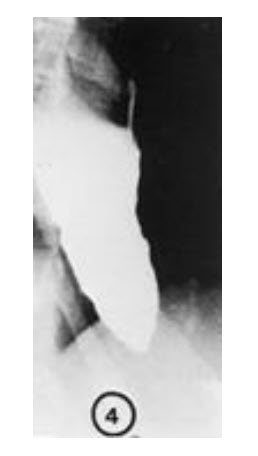Question 21#
A 72-year-old woman notices progressive dysphagia to solids and liquids. There is no history of alcohol or tobacco use, and the patient takes no medications. She denies heartburn, but occasionally notices the regurgitation of undigested food from meals eaten several hours before. Her barium swallow is shown.

Which of the following is the cause of this condition?
A. Growth of malignant squamous cells into the muscularis mucosaB. Scarring caused by silent gastroesophageal reflux
C. Spasm of the lower esophageal sphincter
D. Loss of intramural neurons in the esophagus
E. Psychiatric disease
Correct Answer is D
Comment:
The barium swallow shows the dilated baglike proximal esophagus and tapered distal esophageal ring characteristic of achalasia. This is a motor disorder of the esophagus and classically produces dysphagia to both solids and liquids. Structural disorders such as cancer and stricture usually cause trouble swallowing solids as the first manifestation. In achalasia, manometry shows elevated pressure and poor relaxation of the lower esophageal sphincter. In classic achalasia the contractions of the esophagus are weak, although a variant called vigorous achalasia is associated with large-amplitude prolonged contractions. Medications (nitrates, calcium channel blockers, botox injections into the LES) or physical procedures (balloon dilatation or surgical myotomy) that decrease LES pressure are the recommended treatments. Squamous cell carcinoma would not cause esophageal dilation and would be associated with ratty rather than smooth tapering of the esophagus. Achalasia is not associated with gastroesophageal reflux disease. Although anxiety can cause dysphagia and a globus-like sensation in the cricoid region, it would not cause the anatomical changes seen on this barium swallow.